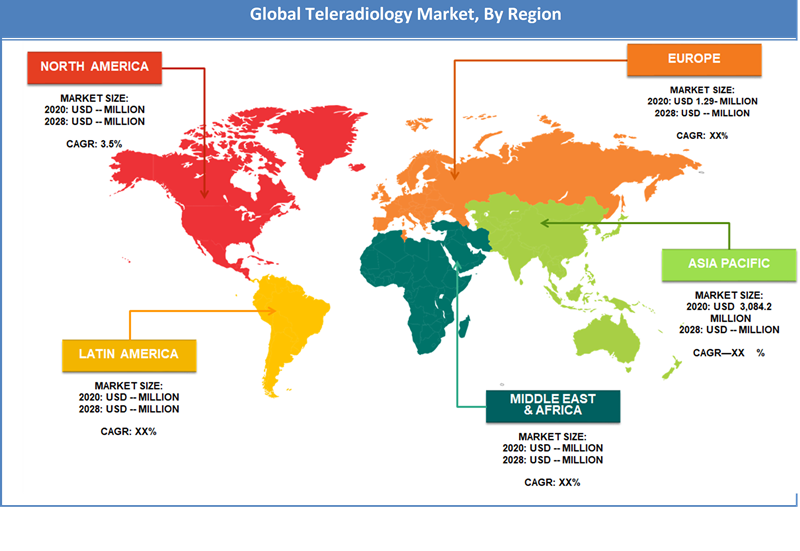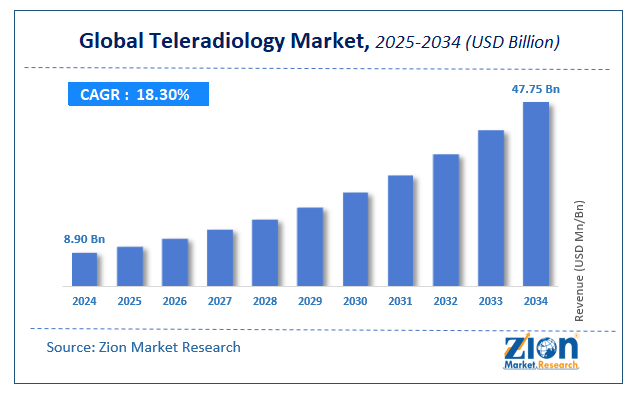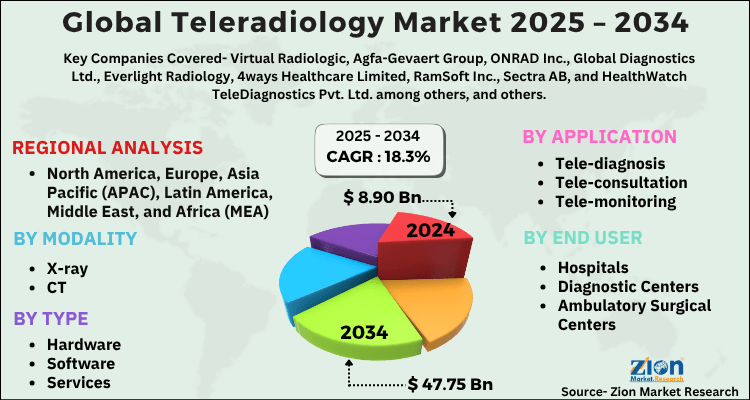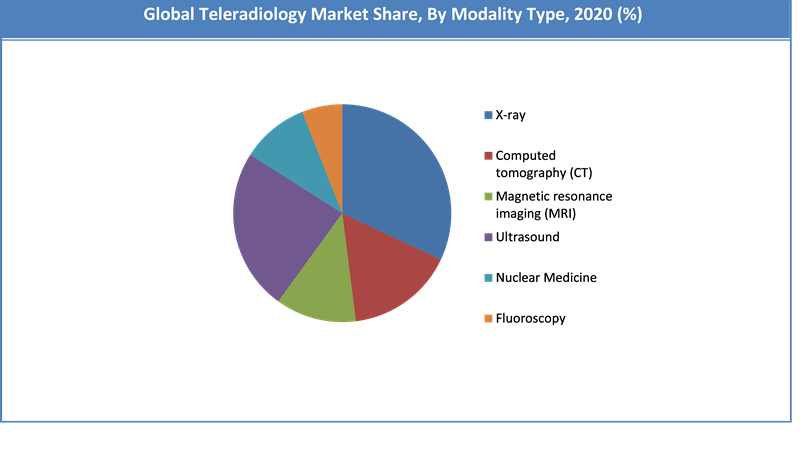Teleradiology Market Size, Share, Analysis Report 2034

Teleradiology Market By Modality (X-ray, CT, MRI, Ultrasound, Nuclear Imaging, and Mammography), By Type (Hardware, Software, and Services), By Application (Tele-diagnosis, Tele-consultation, and Tele-monitoring), By End-user (Hospitals, Diagnostic Centers, Ambulatory Surgical Centers, and Others), and By Region: Global and Regional Industry Overview, Market Intelligence, Comprehensive Analysis, Historical Data, and Forecasts 2025 - 2034
| Market Size in 2024 | Market Forecast in 2034 | CAGR (in %) | Base Year |
|---|---|---|---|
| USD 8.90 Billion | USD 47.75 Billion | 18.3% | 2024 |
Teleradiology Market: Industry Perspective
The global teleradiology market size was worth around USD 8.90 billion in 2024 and is predicted to grow to around USD 47.75 billion by 2034 with a compound annual growth rate (CAGR) of roughly 18.3% between 2025 and 2034. The report analyzes the global teleradiology market's drivers, restraints/challenges, and the effect they have on the demand during the projection period. In addition, the report explores emerging opportunities in the teleradiology industry.
Teleradiology Market: Overview
The global teleradiology market is majorly enhanced by technological advancements in teleradiology everywhere on the planet. Other major factors are the rising geriatric population base and elevation in healthcare expenditure, paired with an elevated occurrence of chronic disorders. On the opposite hand, technology paired with a possible lack of skilled technicians & radiologists are the main hindering factors which will hamper the growth of the teleradiology market.
However, high rates of penetration by Internet & smartphones, paired with elevated healthcare awareness amongst patients everywhere on the planet, are expected to reveal new growth opportunities for the teleradiology market within the forecast period. In addition to the present, various government initiatives will also support the growth of the worldwide teleradiology market.
Teleradiology is the process of electronic transmission of radiologic images from one location to another for the interpretation and/or consultation. Teleradiology allows for more timely interpretation of radiologic images and helps in giving greater access to secondary consultations. The major advantage of teleradiology is that users in different locations may simultaneously view the images. Teleradiology is widely implemented by hospitals, urgent care clinics, and specialist imaging companies to address staff shortages, to provide radiological services and to address the lack of expertise. The teleradiology process includes: image acquisition and storage station, an image sending station, a transmission network and a receiving image station that must have a high-quality display screen that has been cleared for clinical purposes. Teleradiology benefits both the patients as well as the radiologists. Various advantages of teleradiology for the patients include the availability of top radiologists for the interpretation of the findings, as well the findings are obtained in a very short period of time and even the costs of travel for the patients, accommodation, and absence from their workplace are minimized.
In countries like the US and UK, radiological scans performed are increasing, whereas the shortage of radiologists persists. Also, developing countries like India experience a shortage of radiological experts in rural areas. During night hours, emergency conditions lack of availability of diagnostic services, cause great problems. Teleradiology plays an important role in outsourcing radiology interpretation or diagnosis and assures competent and timely professional help. Thus, the use of teleradiology has become of prime importance in remote locations, at night hours and in emergencies.
Key Insights
- As per the analysis shared by our research analyst, the global teleradiology market is estimated to grow annually at a CAGR of around 18.3% over the forecast period (2025-2034).
- Regarding revenue, the global teleradiology market size was valued at around USD 8.90 billion in 2024 and is projected to reach USD 47.75 billion by 2034.
- The teleradiology market is projected to grow at a significant rate due to the Shortage of radiologists and demand for faster diagnosis, driving adoption. Growth in telemedicine and remote healthcare access further supports the market.
- Based on Modality, the X-ray segment is expected to lead the global market.
- On the basis of Type, the Software segment is growing at a high rate and will continue to dominate the global market.
- Based on the Application, the Tele-diagnosis segment is projected to swipe the largest market share.
- By End-user, the Hospitals segment is expected to dominate the global market.
- Based on region, North America is predicted to dominate the global market during the forecast period.
Teleradiology solutions also help to enhance the efficiency of diagnostic imaging by optimizing and simplifying radiology with accurate reads and reducing human/manual errors. However, this industry is facing monetary, staffing, and logistics challenges as a variety of radiologists are getting into the cluster of telehealth and teleradiology. Also, there are internet bandwidth issues, especially in rural hospital settings, and other people living in rural areas are hesitant to simply accept teleradiology reports due to data breach issues.
Teleradiology Market: Dynamics
Due to the outbreak of the coronavirus globally, there's a sudden rise in the demand for teleradiology services. The growth of this market is especially attributed to the increasing geriatric population and, therefore, the subsequent upsurge in the prevalence of associated diseases, the increasing adoption of cloud-based solutions, and the benefits offered by teleradiology and a shortage of skilled radiologists. However, declining reimbursements and increasing regulatory burden within the US, and data breaches of imaging reports, hampered market growth to an extent.
Teleradiology Market: Segmentation Analysis
The global teleradiology market is segmented based on modality, type, application, end-user, and region.
Based on Modality, the global teleradiology market is divided into X-ray, CT, MRI, ultrasound, nuclear imaging, and mammography. X-ray was the dominant segment owing to high usage in primary diagnosis, economical pricing, and the introduction of innovative systems, such as filmless x-ray systems are some of the factors responsible for the segment’s dominance.
On the basis of Type, the global teleradiology market is bifurcated into hardware, software, and services. The software sector is likely to develop in the teleradiology market at the quickest rate shortly, owing to the increasing demand for healthcare software to improve interoperability, enhance technical capabilities, and enhance data transparency.
By Application, the global teleradiology market is split into tele-diagnosis, tele-consultation, and tele-monitoring.
In terms of End-users, the global teleradiology market is categorized into hospitals, diagnostic centers, ambulatory surgical centers, and others.
Teleradiology Market: Report Scope
| Report Attributes | Report Details |
|---|---|
| Report Name | Teleradiology Market |
| Market Size in 2024 | USD 8.90 Billion |
| Market Forecast in 2034 | USD 47.75 Billion |
| Growth Rate | CAGR of 18.3% |
| Number of Pages | 160 |
| Key Companies Covered | Virtual Radiologic, Agfa-Gevaert Group, ONRAD Inc., Global Diagnostics Ltd., Everlight Radiology, 4ways Healthcare Limited, RamSoft Inc., Sectra AB, and HealthWatch TeleDiagnostics Pvt. Ltd. among others. |
| Segments Covered | By Modality, By Type, By Application, By End-user, and By Region |
| Regions Covered | North America, Europe, Asia Pacific (APAC), Latin America, The Middle East and Africa (MEA) |
| Base Year | 2024 |
| Historical Year | 2020 to 2023 |
| Forecast Year | 2025 - 2034 |
| Customization Scope | Avail customized purchase options to meet your exact research needs. Request For Customization |
Teleradiology Market: Regional Analysis
North America is predicted to remain the leading area within the teleradiology market in the years to come. Demand for teleradiology was uppermost in North America, particularly within the U.S., boosting the teleradiology market. Europe was the second biggest market, followed by the Asia Pacific. Asia Pacific is probably going to be developing at the highest CAGR over the years to return for the teleradiology market. Additionally, Latin America and the Middle East & Africa are also likely to exhibit perceptible development for the teleradiology market within the coming years.
 Request Free SampleTeleradiology Market: Regional Analysis
Request Free SampleTeleradiology Market: Regional Analysis
The report provides a company market share analysis to give a broader overview of the key market players. In addition, the report also covers key strategic developments of the market, including acquisitions & mergers, new product launches, agreements, partnerships, collaborations & joint ventures, research & development, and regional expansion of major participants involved in the teleradiology market on a global and regional basis.
The global teleradiology market is dominated by players like:
- Virtual Radiologic
- Agfa-Gevaert Group
- ONRAD Inc.
- Global Diagnostics Ltd.
- Everlight Radiology
- 4ways Healthcare Limited
- RamSoft Inc.
- Sectra AB
- HealthWatch TeleDiagnostics Pvt. Ltd.
The global Teleradiology Market is segmented as follows:
By Modality
- X-ray
- CT
- MRI
- Ultrasound
- Nuclear Imaging
- Mammography
By Type
- Hardware
- Software
- Services
By Application
- Tele-diagnosis
- Tele-consultation
- Tele-monitoring
By End-user
- Hospitals
- Diagnostic Centers
- Ambulatory Surgical Centers
- Others
By Region
- North America
- The U.S.
- Canada
- Europe
- France
- The UK
- Spain
- Germany
- Italy
- Rest of Europe
- Asia Pacific
- China
- Japan
- India
- South Korea
- Southeast Asia
- Rest of Asia Pacific
- Latin America
- Brazil
- Mexico
- Rest of Latin America
- Middle East & Africa
- GCC
- South Africa
- Rest of Middle East & Africa
Table Of Content
Methodology
FrequentlyAsked Questions
Teleradiology is a subspecialty of telemedicine that involves the remote transmission of radiographic images, such as X-rays, CT scans, and MRIs, from one site to another for interpretation and diagnosis by a radiologist or another qualified medical expert.
The global teleradiology market is expected to grow due to a shortage of radiologists and demand for faster diagnosis, driving adoption. Growth in telemedicine and remote healthcare access further supports the market.
According to a study, the global teleradiology market size was worth around USD 8.90 Billion in 2024 and is expected to reach USD 47.75 Billion by 2034.
The global teleradiology market is expected to grow at a CAGR of 18.3% during the forecast period.
North America is expected to dominate the teleradiology market over the forecast period.
Leading players in the global teleradiology market include Virtual Radiologic, Agfa-Gevaert Group, ONRAD Inc., Global Diagnostics Ltd., Everlight Radiology, 4ways Healthcare Limited, RamSoft Inc., Sectra AB, and HealthWatch TeleDiagnostics Pvt. Ltd., among others.
The report explores crucial aspects of the teleradiology market, including a detailed discussion of existing growth factors and restraints, while also examining future growth opportunities and challenges that impact the market.
RelatedNews
HappyClients
Zion Market Research
Tel: +1 (302) 444-0166
USA/Canada Toll Free No.+1 (855) 465-4651
3rd Floor,
Mrunal Paradise, Opp Maharaja Hotel,
Pimple Gurav, Pune 411061,
Maharashtra, India
Phone No +91 7768 006 007, +91 7768 006 008
US OFFICE NO +1 (302) 444-0166
US/CAN TOLL FREE +1 (855) 465-4651
Email: sales@zionmarketresearch.com
We have secured system to process your transaction.
Our support available to help you 24 hours a day, five days a week.
Monday - Friday: 9AM - 6PM
Saturday - Sunday: Closed







